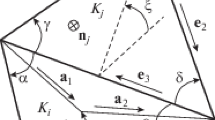Abstract
Numerical simulations of vortex sheets have a long history. The major advantage of the vortex sheet model lies in the efficiency of its boundary integral formulation, which allows us to avoid expensive computations of volumetric equations in some important problems. Although some researchers in computer graphics have exploited this benefit, there seems to be ample room for further improvements to their methods in relation to new results achieved in the applied mathematics community. On the other hand, applied mathematicians also could gain insight into flexible treatment of moving surfaces, which are very common in the current CG community. In this paper, we give an overview of recent progress in numerical simulations of the motion of three-dimensional vortex sheets with surface tension and discuss open problems that interests researchers in both communities referring to important papers from graphics.
Access this chapter
Tax calculation will be finalised at checkout
Purchases are for personal use only
Similar content being viewed by others
References
Ambrose DM, Masmoudi N (2007) Well-posedness of 3D vortex sheets with surface tension. Commun Math Sci 5(2):391–430
Ambrose DM, Siegel M (2012) A non-stiff boundary integral method for 3D porous media flow with surface tension. Math Comput Simul 82(6):968–983
Ambrose DM, Siegel M, Tlupova S (2013) A small-scale decomposition for 3D boundary integral computations with surface tension. J Comput Phys 247:168–191
Anderson CR (1986) A method of local corrections for computing the velocity field due to a distribution of vortex blobs. J Comput Phys 62(1):111–123
Beale JT, Majda A (1985) High order accurate vortex methods with explicit velocity kernels. J Comput Phys 58(2):188–208
Brochu T, Bridrson R (2009) Robust topological operations for dynamic explicit surfaces. SIAM J Sci Comput 31(4):2472–2493
Brochu T, Keeler T, Bridrson R (2012) Linear-time smoke animation with vortex sheets. Proc Symp Comput Anim 87–95
Caflisch RE, Li X-F (1992) Lagrangian theory for 3D vortex sheets with axial or helical symmetry. Transp Theory Stat Phys 21:559
Cheng H, Greengard L, Rokhlin V (1999) A fast adaptive multipole algorithm in three dimensions. J Comput Phys 155(2):468–498
Chorin AJ, Bernard PS (1973) Discretization of a vortex sheet, with an example of roll-up. J Comput Phys 13(3):423–429
Da F, Batty C, Grinspun E (2014) Multimaterial mesh-based surface tracking. ACM Trans Graph 33(4):112
Da F, Batty C, Wojtan C, Grinspun E (2015) Double bubbles sans toil and trouble: discrete circulation-preserving vortex sheets for soap films and forms. ACM Trans Graph 34(4):149
Da F, Hahn D, Batty C, Wojtan C, Grinspun E (2016) Surface-only liquids. ACM Trans Graph 35(4):78
Enright D, Marschner S, Fedkiw R (2002) Animation and rendering of complex water surfaces. ACM Trans Graph 21(3):736–744
Epstein CL, Gage M (1987) The curve shortening flow, Wave motion: theory, modelling, and computation (Berkeley, Calif., 1986). Math Sci Res Inst Publ 7:15–59. Springer
Hou TY, Lowengrub JS, Shelly MJ (1994) Removing the stiffness from interfacial flows with surface tension. J Comput Phys 114(2):312–338
Hou TY, Lowengrub JS, Shelly MJ (1998) The long-time motion of vortex sheets with surface tension. Phys Fluids 9:1933
Kim D, Song O-Y, Ko H-S (2009) Stretching and wiggling liquids. ACM Trans Graph 28(5):120
Lundgren TS, Mansour NN (1988) Oscillations of drops in zero gravity with weak viscous effects. J Fluid Mech 194:479–510
Moore DW (1979) The spontaneous appearance of a singularity in the shape of an evolving vortex sheet. Proc R Soc Lond A 365:105–119
Nie Q (2001) The nonlinear evolution of vortex sheets with surface tension in axisymmetric flows. J Comput Phys 174(1):438–459
Nitsche M, Steen PH (2004) Numerical simulations of inviscid capillary pinchoff. J Comput Phys 200(1):299–324
Pfaff T, Thuerey N, Gross M (2012) Lagrangian vortex sheets for animating fluids. ACM Trans Graph 31(4):112
Saffman PG (1995) Vortex dynamics. Cambridge University Press, UK
Stam J (1999) Stable fluids. SIGGRAPH 99 Conference Proceedings. Annual conference series, 121–128
Zhang X, Bridson R (2014) A PPPM fast summation method for fluids and beyond. ACM Trans Graph 33(6):206
Author information
Authors and Affiliations
Corresponding author
Editor information
Editors and Affiliations
Rights and permissions
Copyright information
© 2019 Springer Nature Singapore Pte Ltd.
About this chapter
Cite this chapter
Koga, K., Funakoshi, M. (2019). Recent Progress in Simulations of 3D Vortex Sheets with Surface Tension. In: Dobashi, Y., Kaji, S., Iwasaki, K. (eds) Mathematical Insights into Advanced Computer Graphics Techniques. MEIS MEIS 2016 2017. Mathematics for Industry, vol 32. Springer, Singapore. https://doi.org/10.1007/978-981-13-2850-3_9
Download citation
DOI: https://doi.org/10.1007/978-981-13-2850-3_9
Published:
Publisher Name: Springer, Singapore
Print ISBN: 978-981-13-2849-7
Online ISBN: 978-981-13-2850-3
eBook Packages: EngineeringEngineering (R0)



